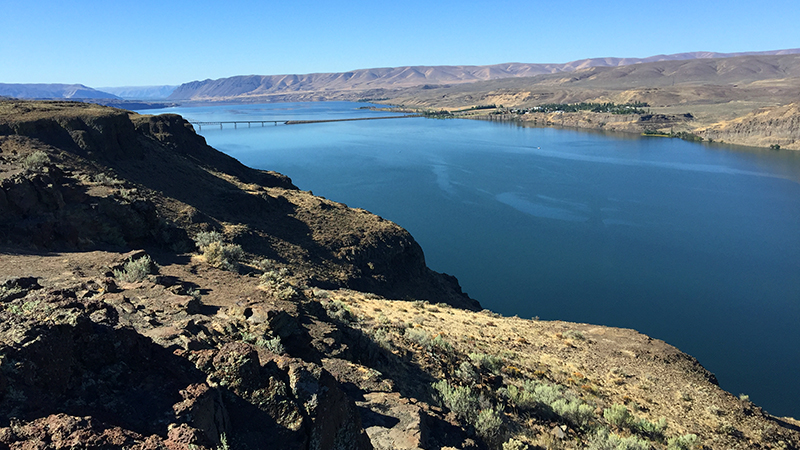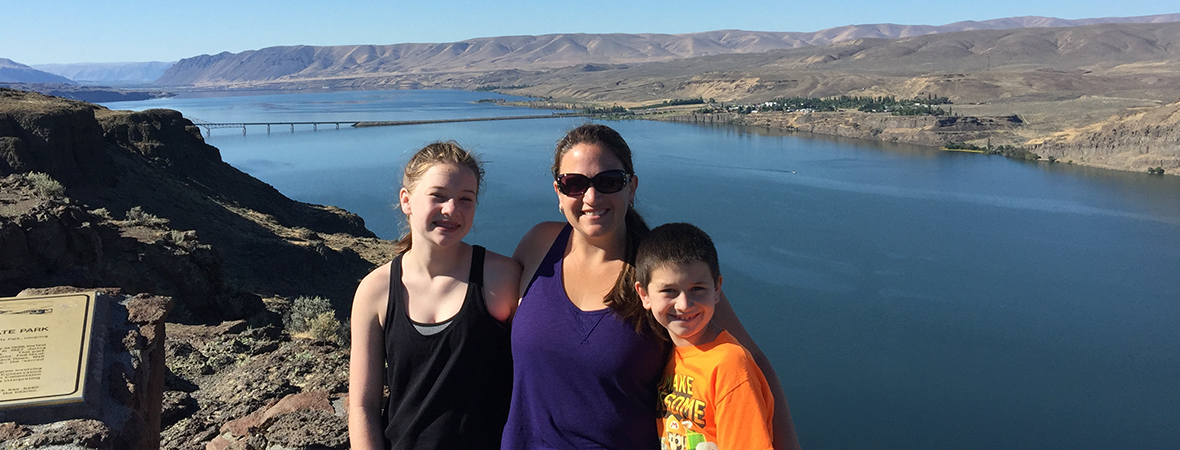
The Wanapum Viewpoint, also called the I-90 Scenic Viewpoint and the Columbia River Scenic Overlook, sits off I-90 in Washington State. This roadside viewpoint has incredible panoramic views of the Columbia River, the Wanapum Reservoir, the Vantage Bridge, and the Ginkgo Petrified Forest State Park. Interpretive displays and signs provide information about the area’s geological history, the native Wanapum Indians, and the Ginkgo Petrified Forest.
Here’s what the displays say about the area:
Geological History
Millions of years ago, this region was humid and the topography was a network of streams and hills. There was no Cascade Range and moisture-laden clouds sweeping inland from the Pacific created an environment where a diversified forest thrived.
Over time, floods of molten basaltic lava welled up through fissures in the earth’s crust, eventually engulfing the area in lava several thousand feet thick. Between eruptions lakes and marshes formed and forests grew. With each lava flow, the forests were destroyed and some logs were petrified.
With the outpouring of lava, the raising of the Cascade Range began. This uplift cut off the moist winds from the west, leaving Eastern Washington an arid region. Erosion by the elements, rivers, and floods cut through one lava flow after another, exposing the petrified wood as it is seen today.

Highways Of The Past
Before the days of the railroad, the transportation of mail and interstate travel were dependent on public roads and the federal government encouraged the development of post roads used for the distribution of the US Mail. Then with the coming of the railroad, the government switched its interest from roads to railroads as a better means of interstate travel. It wasn’t until the rise of the motor car that the federal government once again renewed its interest on public roads.
By 1906, the need for a better organization to build roads was recognized and the State Legislature established the Department of Highways. Stagecoach and covered wagon trails slowly gave way to dirt roads, which were passable in the dry weather. The dirt roads were then succeeded by macadam, and occasionally, fir plank roads.
Remnants of the early roads can be seen in the valley below the viewpoint. The first roads in the area were constructed around 1918 and followed the contour of the hillside down to a ferry landing. In 1930, an improved highway was constructed.
The Wanapum Indians
Until recent times, the Wanapum Indians inhabited the banks of the Columbia River from Beverly Gap to where it is joined by the Snake River near Pasco about 75 miles south of the viewpoint. The Wanapums were a very religious and peaceful people, living on fish, venison, berries, and roots. They were expert fishermen, using nets, spears, and woven willow traps.
The Wanapum Indians never fought the whites and as a result, they signed no treaties and received no special territorial rights. Although numbering in the thousands at one time, the Wanapums are now virtually extinct.

Ginkgo Petrified Forest State Park
Ginkgo Petrified Forest State Park is a 7,470-acre park with year-round camping at Wanapum recreational area. The park features 27,000 feet of freshwater shoreline and was created as a national historic preserve in the 1930s after petrified wood was discovered in the region.
Although the presence of petrified wood has been reported as early as 1898, the first indication of its presence in quantity in this vicinity was realized in 1927 during construction of the highway between Ellensburg and Vantage. This park represents one of the most unusual petrified wood areas in the world. Few localities yield a flora so diverse and only rarely are they preserved in lava flows. Well over 200 varieties of wood have been identified, including Ginkgo, the sacred tree of China. The Ginkgo no longer exists in the wild state.
Development was initiated in the 1930s through a cooperative program involving the State of Washington, the National Park Service, and the Civilian Conservation Corps. Since that time, the Washington State Parks and Recreation Commission has developed a modern Interpretive Center with exhibits on the area’s geological story. Because of its unique character, Ginkgo Petrified Forest State Park has been designated a Registered National Landmark by the US Department of the Interior.